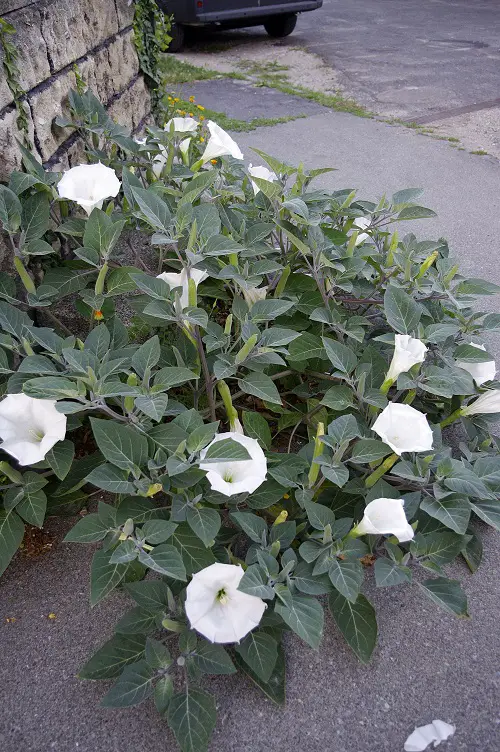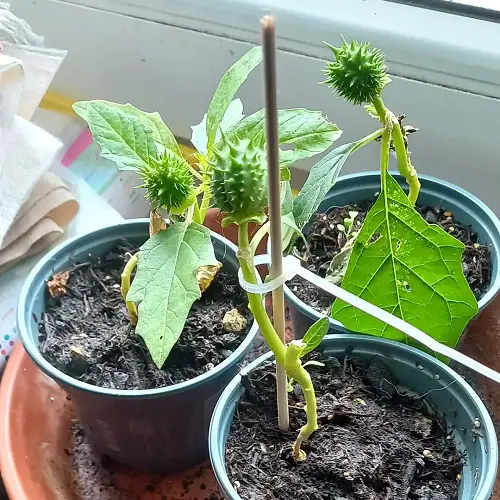Learn all about Growing Datura. Know How to Grow Jimonseed for its medicinal properties and low maintenance needs!

The Datura plant is native to America and Mexico and is often associated with similar species like the Devil’s Trumpet or Angel’s Trumpet. Growing Datura is easy, and this medicinal herb doesn’t require special care or attention. Here’s a guide with all information on How to Grow Jimonseed.
Botanical Name: Datura inoxia,
USDA Zones: 9 – 11
Common Names— Jimson weed, Devil’s snare, thornapple, moonflower, hell’s bells, Devil’s trumpet, Devil’s weed, tolguacha, Jamestown weed, stinkweed, locoweed, pricklyburr, and Devil’s cucumber
Check out these night-blooming fragrant flowers with strong scents here
Datura Plant Information

With gray-green, pale leaves, the plant also produces flowers that bloom in the shape of trumpets only during the night. This perennial flowering plant is native to warmer zones and is grown annually in colder places.
Datura looks like a small shrub that grows wider than taller. It can grow up to 1-2 feet tall and 4-5 feet wide. With oval-shaped, dark green leaves that can grow up to 6-8 inches long, the plant produces fragrant blooms in summer and fall.
Check out some amazing bell-shaped flowers here
Propagating Datura
Jimsonweed or Datura can be propagated by division or root cutting, stem cuttings, or seeds.
Propagate Datura via Division
Follow the steps to propagate Jimsonweed via division:
- Cut the tuberous rootball in halves, or quarters on top of a hard, flat surface using a sharp and clean knife. Use a trowel or hand shovel to dig out the root ball carefully. Be careful with this toxic plant, and wear hand gloves while handling it.
- Take each root cutting and transplant in an individual container with enough drainage.
- For cuttings, snip 5-6 inches of long stems. Do make sure to wear gloves as they secrete sap.
- Fill the pot with loamy, rich soil and make a small hole to plant the cuttings. Water the soil enough to keep it moist but not soggy.
- Place the container in a sunny, warm spot and wait for 3-4 weeks before you spot new growth.
Here are some of the best yellow flowers
Types of Datura

Here are the varieties of Datura, or Jimsonweed:
- Datura Metel: It is a bit more cold-tolerant than the usual Datura but similar in many ways.
- Datura Stramonium: It is also known as Jimsonweed or Thorn Apple. It is most known for its prickly, small seed capsules.
- Datura Ferox: It is also called the Long-Spined Thorn Apple. It sports large spines on the seed pods.
Find out the 30 Best Dainty Flowers here
Growing Requirements of Datura

Sunlight
Datura or Jimsonweed prefers to grow in a location that receives 6-8 hours of sunlight on most days. It can also work in a shaded spot but will produce lesser flowers and look weak.
Soil
Humus-rich, well-drained, and loamy soil with excellent drainage is required for Growing Datura. However, it tolerates a variety of soil types.
Watering
Water your Datura regularly when it is established to keep it moist but not soggy. Once matured, it doesn’t need regular watering as it looks for water deep into the soil using its long taproot.
Temperature and Humidity
Datura loves warm temperatures and can tolerate heat as long as the moisture needs are fulfilled. However, it’s not very cold-hardy, and freezing temperatures can kill it. It should be grown in temperatures above 50°F or 10°C.
Moreover, humidity usually is not a problem for the plant that receives proper water.
Check out the best fragrant houseplants you can grow
Datura Care

Fertilizer
The plant is used to growing in the worst of conditions and thrives without any fertilizer. You can amend the soil with organic matter when planting to give it a little boost in growth.
Pruning
Prune off damaged, decayed, dead, or diseased parts of the plant. Typically, pruning is not necessary, but you can trim the plant lightly during the growing season. It will keep the plant at a desired shape and height.
Pests and Diseases
The plant is not bothered by pests and diseases much. However, spider mites, whiteflies, and mealybugs may attack it. Be careful not to overwater as, like any other plant; it can get affected by root rot.
Check out the best ornamental shade-loving plants here
Uses and Effects of Datura
Datura stramonium contains potent alkaloids. The plant, if ingested, can cause hallucinations, tachycardia, muscle weakness, and amnesia.
It is mainly used for medicinal purposes as a sedative. Ayurveda uses it to treat asthma or cough. The seeds are analgesic, anti-inflammatory, and anthelmintic and are used in treating intestinal and stomach pain due to worm infestation.
It can also cure fever and toothache. The fruit juice is used to treat falling hair and dandruff.



DO NOT GROW THIS! It is a deadly poison. The lethal dose is very close to the hallucinogenic dose. It is the famous ‘loco weed’, causing disorientation in cattle and horses, who may stampede and cause injury. It can kill children who eat some. Get another hallucinogen if that is what you want.
DO NOT USE IT FOR MEDICINE if you are not a doctor or licenced, trained professional of the sort who can measure the doses and treat any overdoses. I don’t even know if OD can be treated.
DANGER, better to leave this one alone.
Just don’t eat it
Facts
Overdoses can be treated, just many hospitals dont carry many pharmaceuticals other than what is forced to be ordered. Also you can grow this, its OK, many people like myself have grown these as in/outdoor plants for years or decades. Of course carefully handling the plant & never eating it like Erowid stories is essential. Other than that, it is ok
They all have beautiful flowers ,some species more than others . No one should ever ingest this plant for any reason unless you know what you’re doing.It can kill you.
Thanks for the info! I’m going to throw my seeds in the ground this weekend and hope it grows. Ya its toxic but great for sphinx moths!
I just picked up some of the thorny pods, I assume that’s the seeds. Did yours grow! Did you bury the pod or just leave it on top the ground?
The seeds are inside the thorny pod – when fully ripe it dries & splits open; the seeds are about the size and color of morning glory seed.
i’m growing the double purple daturas and double yellow, also white doubles; not concerned with eating them; i just want to enjoy the spectacular blooms. Also, i’m always trying to get more hummingbird action and i’ve heard that they will eagerly flock to datura flowers.
This is a medicinal herb great for allergies, for example. It is not dangerous if you titrate the dose slowly or unless you’re deliberately eating it to trip.
There were some big ones growing in our dog’s pen (we left them because we thought the flowers were pretty).
TOTALLY NOT WORTH IT! My beautiful German Shepard ate some seeds and nearly died. He spent a weeks at the vet just lying in his side nearly paralyzed until his body was able to flush the toxins from his system.
When I pulled the plants up some of the seed pods poked me in the arm and it burned for days.
Do not recommend keeping this plant for any reason, not worth the risk to you or others that might come in contact
There’s a lot of people saying it kills but yet there’s no official reports or articles about any deaths.
Right? In the emergency rooms, it is supportive care and restraints. IV fluids, cardiac monitor and the waiting game.
Silly fearmongerers. Know what you grow, and if it happens to be a moderately poisonous plant like Datura, be aware that it can cause some rather unpleasant effects if not handled with appropriate care.
You would have to ingest quite large amounts to actually cause serious harm to your body, difficult partly due to the nauseating taste of the leaves.
That said, it could most certainly cause some unwanted effects on your mind, even in smaller doses or from handling the plant without proper precautions. That however is not the plant’s fault. Some people actually seek those effects deliberately.
The plant is very beautiful, easy to grow and maintain.
There is no need to tell people to stay away from it and spread unnecessary fear (written with CAPS locked, smh).
As general advice one should reconsider growing any poisonous plants if you have kids or pets around, but otherwise it boils down to proper handling and care. It’s just an ornamental plant, not the devil himself.
Damn straight.
I’ve been growing Datura for about 2 years, but I’ve used it recreationally for much longer. And in the same way that a kitchen knife can be used to prepare a meal or murder someone, Datura can be used as medicine or you can down 3 seed pods and die. It all depends on your *ahem* “Mental Capacity”, as we’ll call it.
I planted a 6” seedling in June and got a 6’ gorgeous plant that produced about 8 new purple and whte flowers every day. The plant wilted with the past few nights’ 30º temps (zone 7), so I cut it down and harvested the 20 or so seeds that have been developing on the plant since August. They’re walnut-like, smooth, not spiky, and still green. Plantable for next year? How to store? I have photos if you would like.
Would love any advice, please.
Dry cool place.
Great plant for the flower garden. Multiple huge white flowers pollinator love. Don’t eat the plant or any part of it. If your dog unfortunately resides in a pen (like the above owner) always check what plants inhabit his meager living arrangements and remove if questionable. You will love this plant. Cool seed pods. I planted some in a pot to make sure I have more for the next year. Sept 2020 – germinated and grew to planting size by March, 2021.
You have photos of both 5 petal and 6 petal flowers. Jimson weed has 5 petals, I don’t know what the 6-petal flower is, maybe an illustration? Evolution? Please explain.
I believe the six petaled ones are Datura Metle, or there’s a very slight chance that it’s a Datura Inoxia that managed to grow violet. But take that with a grain of salt.
This is the only plant that I have actually witness a sound when it blooms! The blooms are quite large and the petals tear apart, making a kissing sound! They smell terrific.
Awesome! I have some and will grow more since I’m not too worried about it.